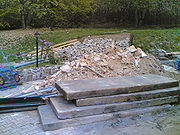
Demolition waste
Encyclopedia

Debris
Debris is rubble, wreckage, ruins, litter and discarded garbage/refuse/trash, scattered remains of something destroyed, or, in geology, large rock fragments left by a melting glacier etc. The singular form of debris is debris...
from destruction of a building. The debris varies from insulation
Building insulation
building insulation refers broadly to any object in a building used as insulation for any purpose. While the majority of insulation in buildings is for thermal purposes, the term also applies to acoustic insulation, fire insulation, and impact insulation...
, electrical wiring
Electrical wiring
Electrical wiring in general refers to insulated conductors used to carry electricity, and associated devices. This article describes general aspects of electrical wiring as used to provide power in buildings and structures, commonly referred to as building wiring. This article is intended to...
, rebar
Rebar
A rebar , also known as reinforcing steel, reinforcement steel, rerod, or a deformed bar, is a common steel bar, and is commonly used as a tensioning device in reinforced concrete and reinforced masonry structures holding the concrete in compression...
, wood
Lumber
Lumber or timber is wood in any of its stages from felling through readiness for use as structural material for construction, or wood pulp for paper production....
, concrete
Concrete
Concrete is a composite construction material, composed of cement and other cementitious materials such as fly ash and slag cement, aggregate , water and chemical admixtures.The word concrete comes from the Latin word...
, and brick
Brick
A brick is a block of ceramic material used in masonry construction, usually laid using various kinds of mortar. It has been regarded as one of the longest lasting and strongest building materials used throughout history.-History:...
s. It also may contain lead
Lead
Lead is a main-group element in the carbon group with the symbol Pb and atomic number 82. Lead is a soft, malleable poor metal. It is also counted as one of the heavy metals. Metallic lead has a bluish-white color after being freshly cut, but it soon tarnishes to a dull grayish color when exposed...
, asbestos
Asbestos
Asbestos is a set of six naturally occurring silicate minerals used commercially for their desirable physical properties. They all have in common their eponymous, asbestiform habit: long, thin fibrous crystals...
or different hazardous materials.
Certain components of demolition waste such as plasterboard are hazardous once landfill
Landfill
A landfill site , is a site for the disposal of waste materials by burial and is the oldest form of waste treatment...
ed. Plasterboard is broken down in landfill conditions releasing hydrogen sulfide
Hydrogen sulfide
Hydrogen sulfide is the chemical compound with the formula . It is a colorless, very poisonous, flammable gas with the characteristic foul odor of expired eggs perceptible at concentrations as low as 0.00047 parts per million...
, a toxic gas.
There is the potential to recycle many elements of demolition waste. Often roll-off
Roll-off (dumpster)
A roll-off is an open top dumpster characterized by a rectangular footprint, utilizing wheels to facilitate rolling the dumpster in place. The open top container is designed to be transported by special roll-off trucks...
containers are used to transport the waste. Rubble can be crushed and reused in construction projects. Waste wood can also be recovered and recycled.
Government or local authorities often make rules about how much waste should be sorted before it is hauled away to landfills or other waste treatment facilities. Some hazardous materials may not be moved, or demolition begun, before the authorities have ascertained that safety guidelines and restrictions have been followed. Among their concerns would be the proper handling and disposal of such toxic elements as lead, asbestos or radioactive materials.
See also
- Construction waste
- List of solid waste treatment technologies
- List of Superfund sites in the United States
- List of topics dealing with environmental issues
- List of waste management companies
- List of waste management topics
- List of waste types
- PollutionPollutionPollution is the introduction of contaminants into a natural environment that causes instability, disorder, harm or discomfort to the ecosystem i.e. physical systems or living organisms. Pollution can take the form of chemical substances or energy, such as noise, heat or light...
- RecyclingRecyclingRecycling is processing used materials into new products to prevent waste of potentially useful materials, reduce the consumption of fresh raw materials, reduce energy usage, reduce air pollution and water pollution by reducing the need for "conventional" waste disposal, and lower greenhouse...
- SuperfundSuperfundSuperfund is the common name for the Comprehensive Environmental Response, Compensation, and Liability Act of 1980 , a United States federal law designed to clean up sites contaminated with hazardous substances...

